I enjoy every Forgotten NY page I write but I think I’m in for some extra enjoyment this week. I stumbled on a folder full of classic signs, part of a powerpoint show I did a few years ago at Greater Astoria Historical Society about classic signage in New York City and elsewhere. I remember it was a snowy night and not a whole lot of people came out except students from LaGuardia Community College. So, perhaps, not all of you have seen these images, though many have appeared on FNY before. I hope that by showing them here, they can be put in some historical context; in addition, many of these signs have gone the way of all things, so presenting them here will revive them however briefly…
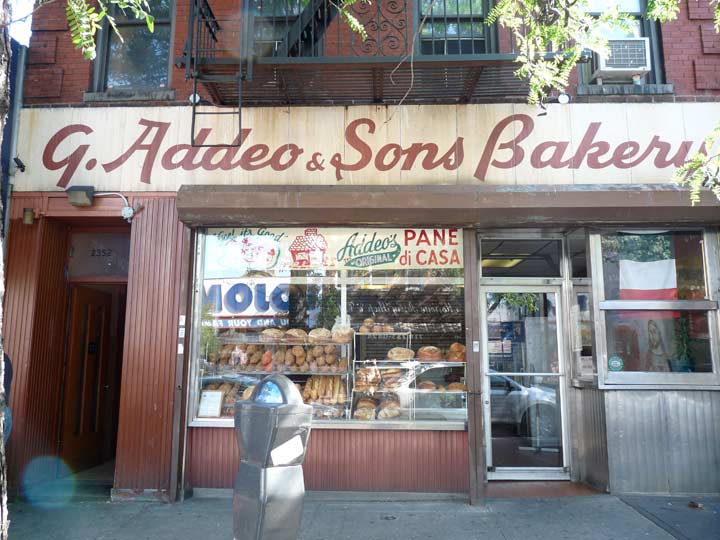
G. Addeo & Sons Bakery, 2352 Arthur Avenue just north of E. 186th Street. This is one of two locations of the venerable Bronx Little Italy bakery; the flagship is actually a block away at Hughes Avenue and East 186th, but both locations sport this classic red and white calligraphed sign.
“Brooks of Sheffield” of Lost City was attracted to the second Addeo Bakery on Hughes Avenue, which also has an old school sign, for the wonders displayed in the window:
The Addeo Bakery is so ridiculously picturesque, it looks like a movie studio cooked it up. I don’t mean the one on Arthur Avenue, but the branch one block away on Hughes Avenue. It partly draws its stark pictorial loveliness from the fact that Hughes is largely unpopulated by shops. Addeo stands alone in Hopperesque glory on a lonely corner all its own. Your can gaze into the shop from two sides. Or just gaze at it from across the street, as I often do when I’m in the neighborhood.
The interior itself is classic and unspoiled. Ornate tile floor, shelves for bread, light fixtures, a scale or two and little else. Many loves of the bakery’s vaunted Pane di Casa—advertised in wonderfully homey, hand-painted signs outside—adorn the window displays. They are crusty and magnificent, and it is a challenge to pass by and not purchase one.
If Addeo is the measure, nearly every other store in New York is an eyesore.
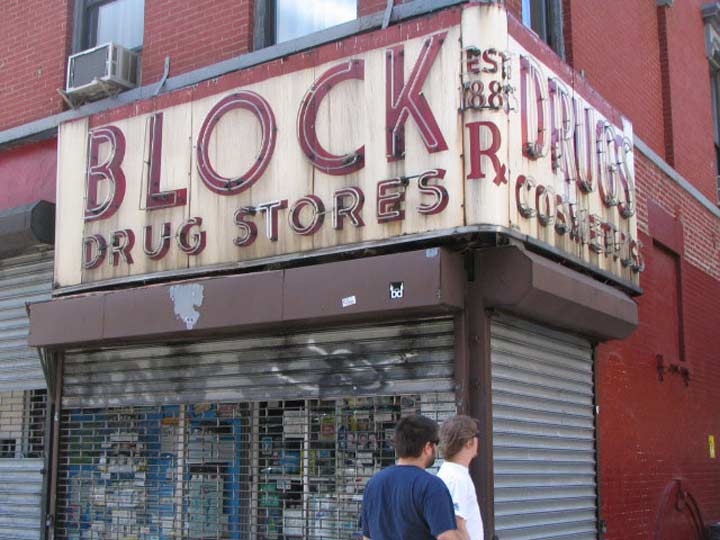
Block Drugs, 2nd Avenue and East 6th Street, is best seen at night when this classic neon sign lights up bright red. The store has been here in the EV since 1885, while the sign has been here since the 1940s. Once again Lost City has some background.
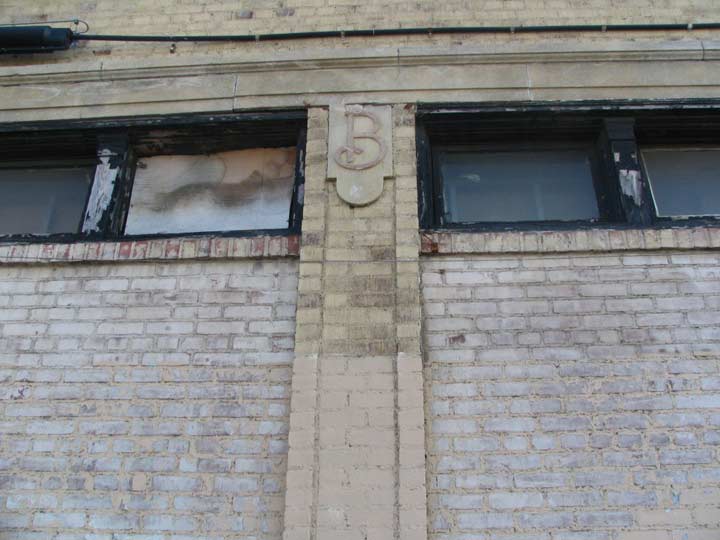
German immigrant Henry C. Bohack opened his first grocery in 1887 and over the years Bohack’s developed into one of the first powerhouse grocery store chains. Grand Union, Key Food and all the rest were to follow. When the Depression arrived in late 1929, Bohack responded by actually opening more stores to provide employment. The founder passed away in 1930. Bohack’s prospered until 1974 when the chain went bankrupt. After an attempted merger with Shoprite failed, Bohacks disappeared into the history books in 1977. Occasionally, though, an old awning or sign is taken down and the Big B is in evidence briefly once more.
This instance, though, is evidence of the major Bohack distributorship at Troutman Street and Flushing Avenue just outside the Brooklyn-Queens Bushwick-Ridgewood border. It’s still marked by a smokestack on which the word “Bohack” can still be clearly seen…
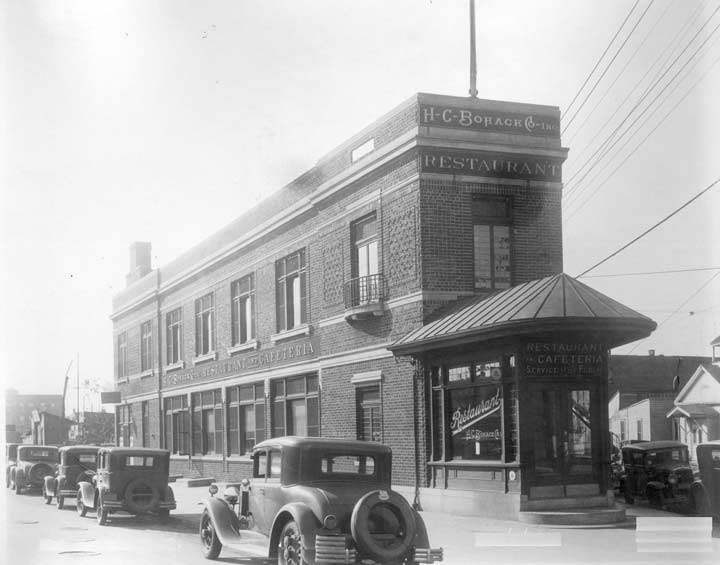
…and a few of the classic “B” entablatures on what was a former Bohack’s restaurant, seen here in 1929. The building remains, and a few of the B’s, but today it is home to a restaurant supply business.
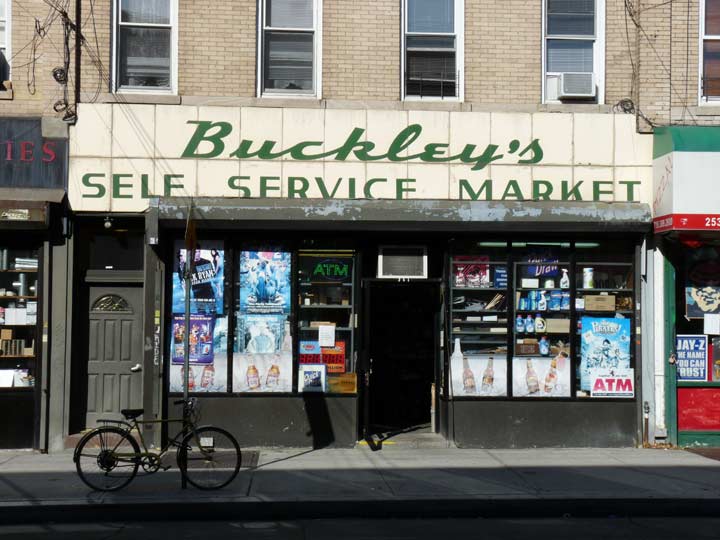
Classic tiled sign at Buckley’s Self Service Market, Nassau and Kingsland Avenues, Greenpoint, Brooklyn.
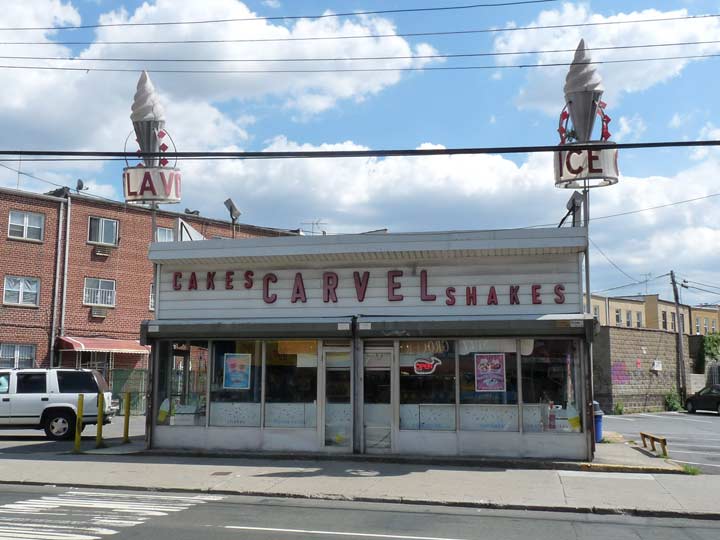
Classic Carvel Ice Cream palace on Metropolitan Avenue east of Forest Avenue, Middle Village. I took this photo before Hurricane Sandy did a number on the revolving ice cream cones. Carvel must have 100 stores in NYC, but this was the only one I know of to retain its decades-old appearance. The revolving cones haven’t been replaced.
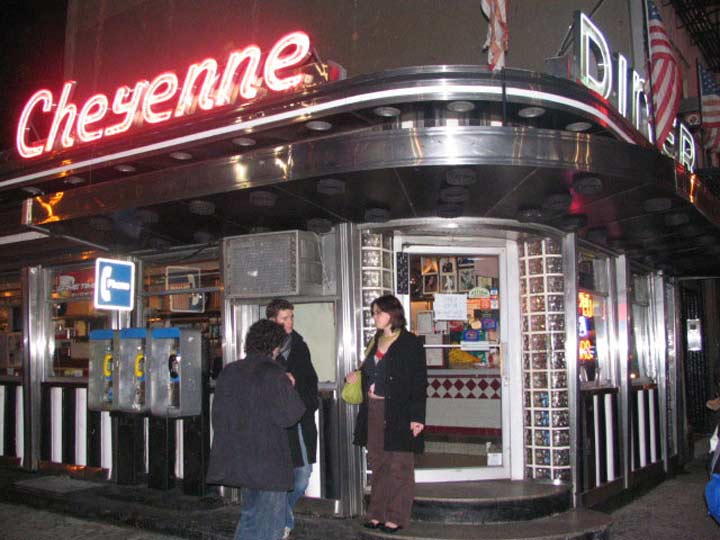
The Cheyenne Diner, and its neon sign, was one of my diner staples when I worked at Macy’s from 2000-2004 and for 4 years thereafter. It closed in 2008, while its property sat empty for several years. In 2016, an apartment building finally went up on the site at 8th Avenue and West 33rd Street. It was frequented by postal workers in the old Farley Building, now being converted to Penn Station West (officially, the Pat Moynihan Train Hall).
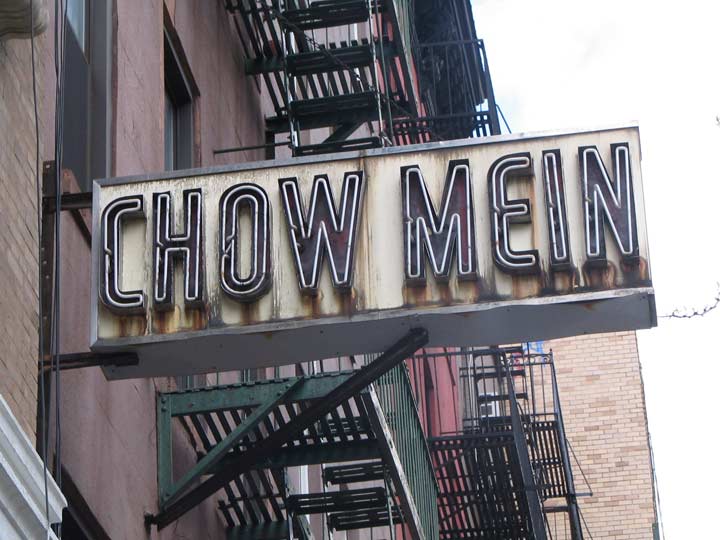
I forget where this neon “Chow Mein” sign was, or still is. Help me out in Comments.
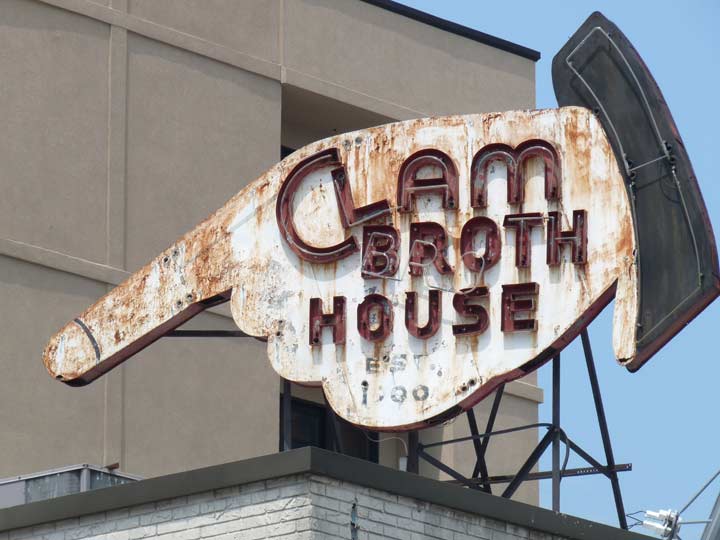
For 112 years Hoboken’s Clam Broth House, River and Newark Streets, dispensed clam juice out of taps, with customers attracted to the place by two huge hand-shaped signs with neon lettering. After the Clam Broth House owners sold the place in 2012 and it became Biggie’s Clam Bar, one of the old signs was allowed to remain, and it survives today.
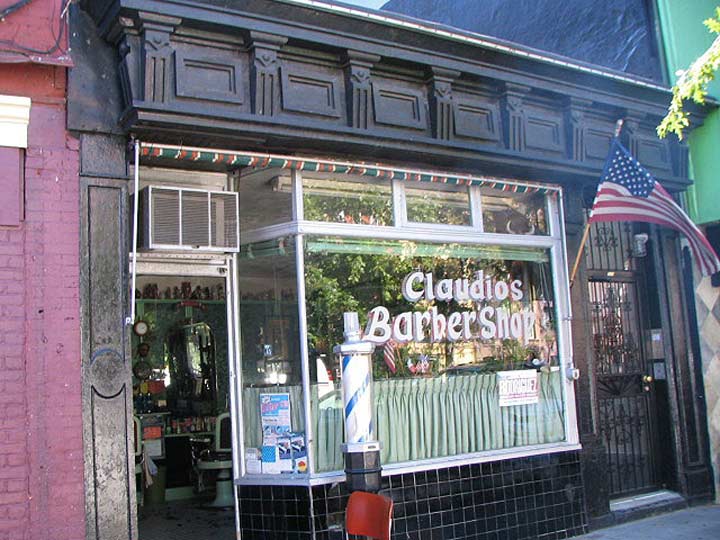
A holdout from the Italian Harlem days is Claudio’s Barbershop, south side of East 116th, just west of 1st Avenue. I expressed my regrets at not having time for a haircut to Claudio, who graciously allowed me to come in and take photos anyway. He said this (July 2010) was his 80th birthday and he had been in business 50 years. Films such as Carlito’s Way and TV shows Law and Order and Third Watch have used the shop for local color, and models in bikinis have posed in the barber chairs for Sports Illustrated shoots. Jimmy Durante and Tammany Hall pol Carmine DeSapio have had their locks chopped here, as well as a number of mob figures. And now, FNY has been here, too.
Since I visited Claudio’s moved a few doors down to 338 East 116th.
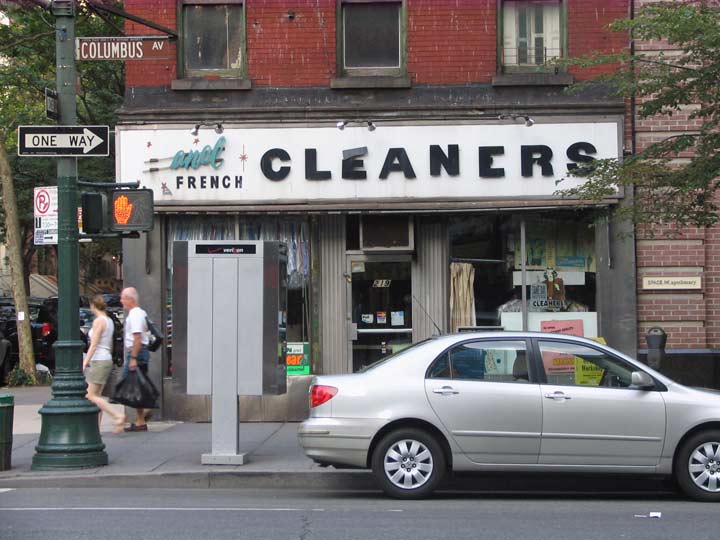
219 Columbus Avenue at West 70th in the Upper West Side just looks like Caravel French Cleaners. Actually the space has now been taken over by Aesop Skin Care. A trend in the past decade is to keep a classic sign even though the original business has moved out and, as we’ll see, even restore it good as new.
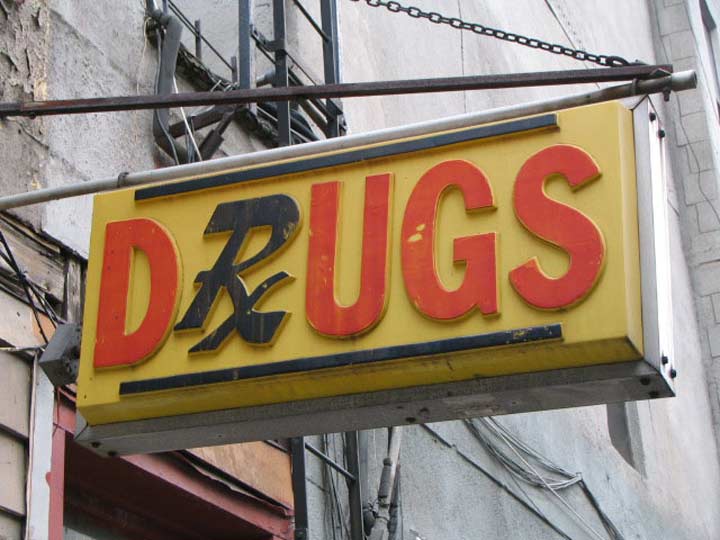
Again, I’m unsure where I found this illuminated drugstore sign with the traditional Latin Rx abbreviation. The other letters in the sign are Franklin Bold condensed, the font I use on my title cards in FNY. I thought it was on DeKalb avenue in Ridgewood, but Street View can’t find it now.
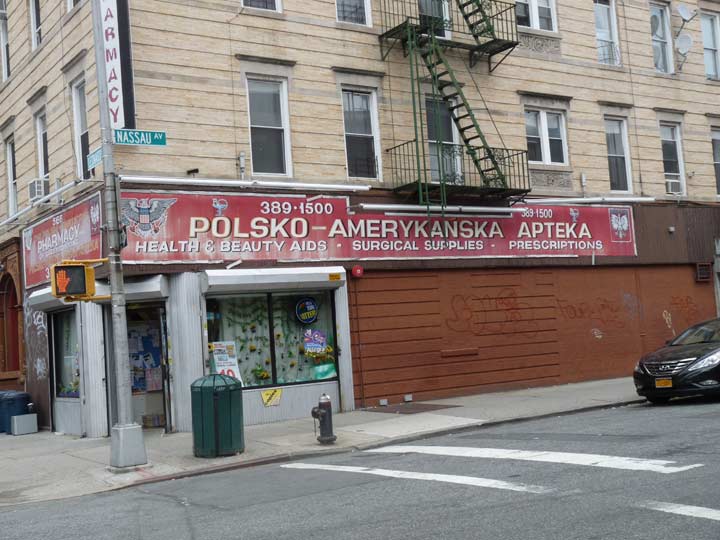
This hand-lettered part-Polish drugstore sign at Nassau Avenue and Leonard Street in Greenpoint is no more and the storefront was empty as of last September.
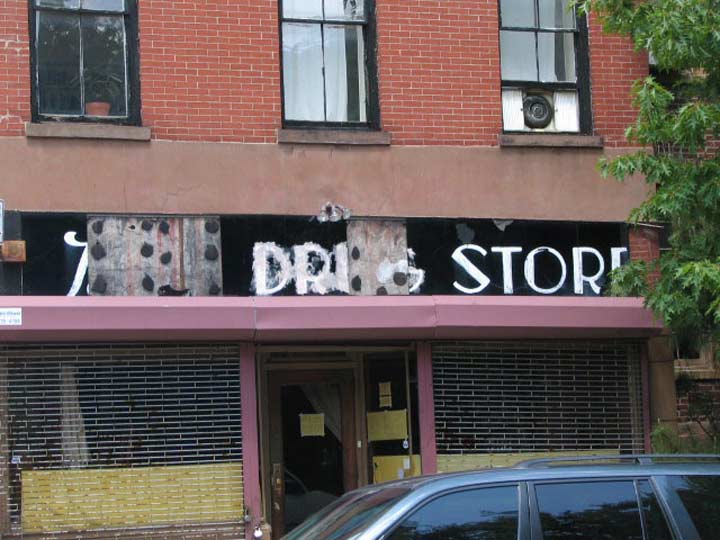
This is one case in which the original business was long gone, the much older sidewalk sign remained…but the new business meticulously restored the old one. In 2001, the owners of Locanda Vini e Olii restaurant, Gates Avenue and Cambridge Place in Clinton Hill, found cabinetry, shelves and signage from the space’s over 100 years as the Lewis Drug Store, and decided to incorporate everything into the new restaurant space. What Locanda’s owners did was unusual. They hired a sign restorer, John Downer, to completely recreate the old sign with black and white glass and he did a masterful job.
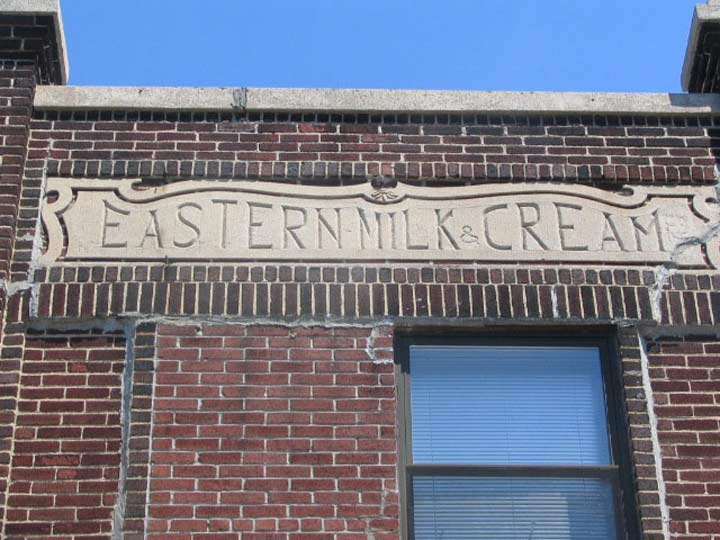
I found this chiseled concrete sign for a distributorship years ago on North 8th Street in Williamsburg. Street View shows no trace of it now, but the street has had quite a few teardowns with new apartment houses going up in recent years.
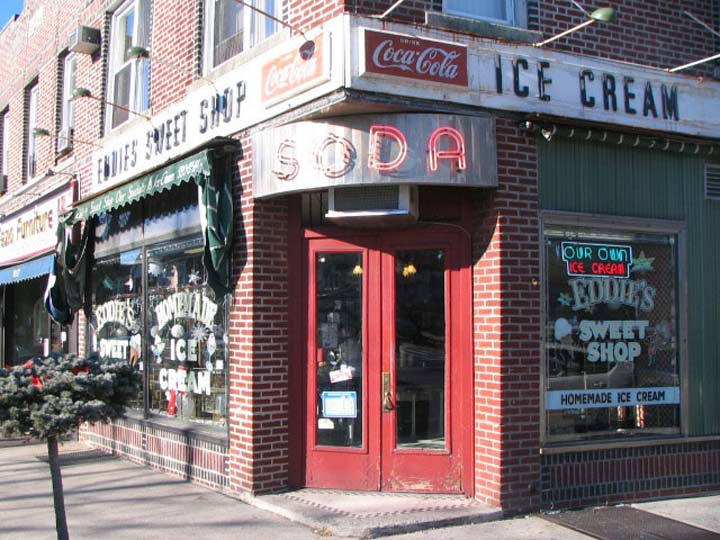
Eddie’s Sweet Shop, which produces handmade milk shakes and sundaes with ice cream made on premises, has its longstanding plastic lettered sign and glass-etched signage on Metropolitan Avenue and 72nd Road in southern Forest Hills. It first opened in 1909.
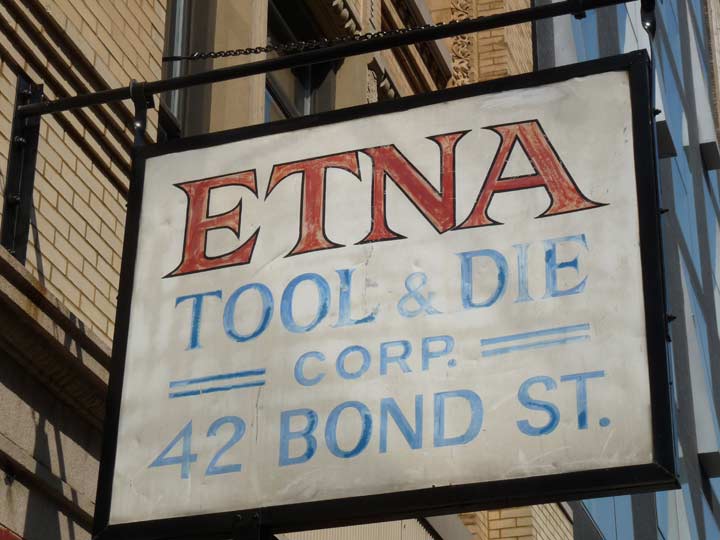
This shingle sign for a tool and die concern on Bond Street was a holdover from a more industrial era in NoHo, which has since become a bastion of high-end retail and expensive apartment buildings. Etna Tool & Die closed its doors in 2017 after a 70-year run. It was a family business and the owner’s daughter is keeping the building, and its hand-lettered sign.
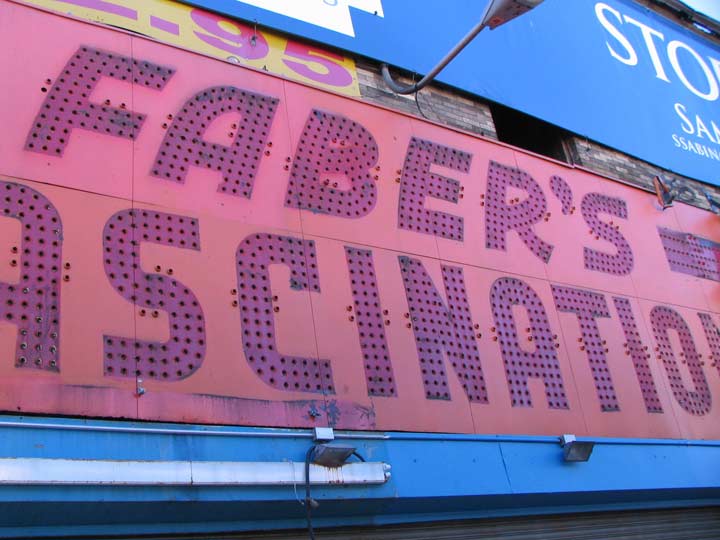
Keep Feeling Faber’s: the Henderson Building on the SE corner of Surf and Stillwell Avenues was demolished in 2010. The building opened as Henderson’s Dance Hall in 1899 and throughout its history hosted stage shows and entertainment, with games on the ground floor as well as food vendors throughout the decades. Its facade was shaved back in the 1920s to accommodate an expansion of Stillwell Avenue. Just before its demolition, an ancient sign illuminated by dozens of lightbulbs for Faber’s Sportland was revealed. In the 1970s, I whiled away hours, and lots of quarters, in Faber’s playing the pinball machines, though I never really got very good at pinball.
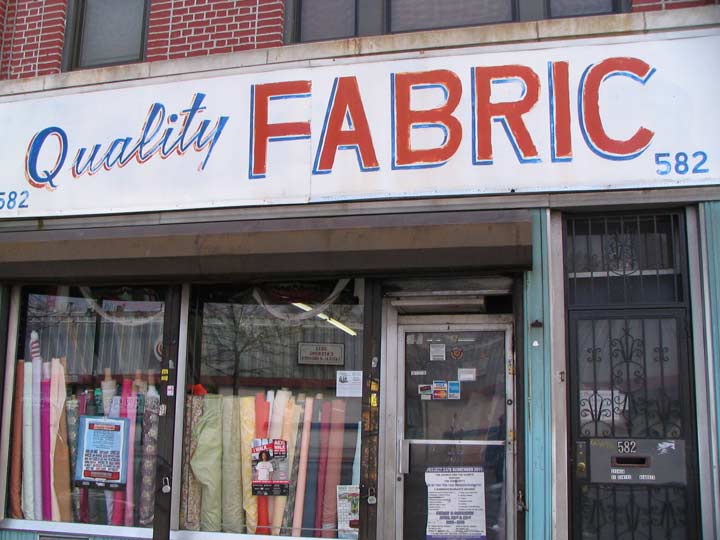
There are a number of interesting signs remaining on Grand Street in Williamsburg between Leonard and Lorimer Streets including this hand-lettered beauty at #582.
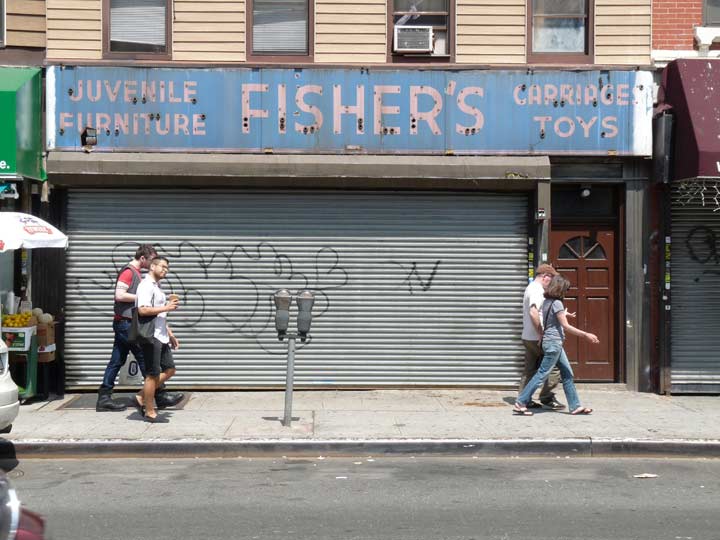
This sign for a furniture-for-children store was revealed, and then covered up again, on Manhattan Avenue in Greenpoint a few years ago.
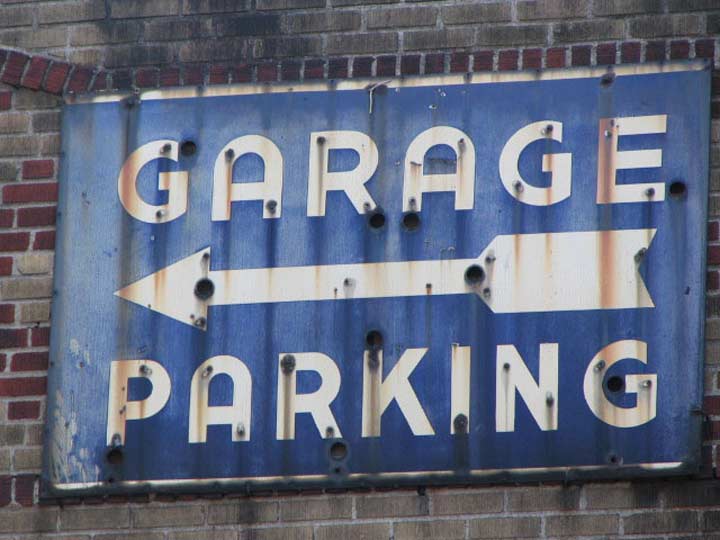
This classic neon sign on a public garage is still hanging in there, as far as I know, on State Street and Willow Place in Brooklyn Heights. The latest Street View shows it hidden by a sidewalk shed.
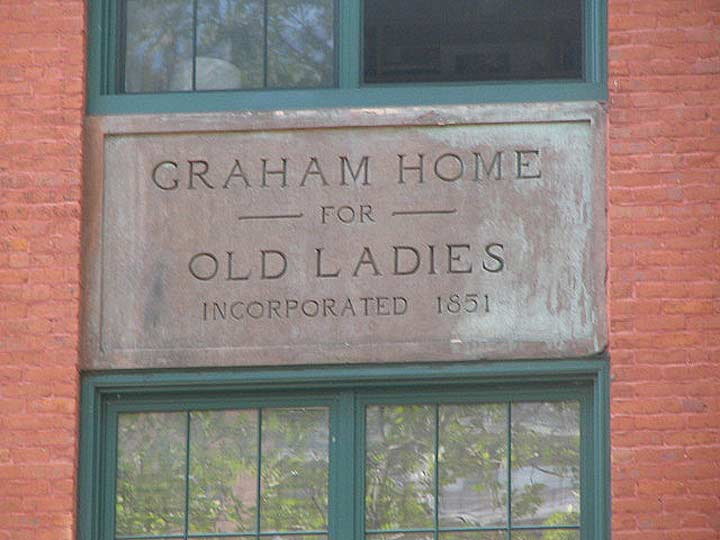
This place on 320 Washington Avenue is pretty old, even by Clinton Hill standards. It was built by lawyer John B. Graham in 1851 as the Brooklyn Society for the Relief of Respectable Aged Indigent Females, a refuge for “indigent gentlewomen…unfitted to accept willingly the public asylum provided by the state.” Women 60 years of age and older were admitted who could provide “satisfactory testimonials of the propriety of her conduct and the respectability of [her] character.”
I have the whole story about this building here.
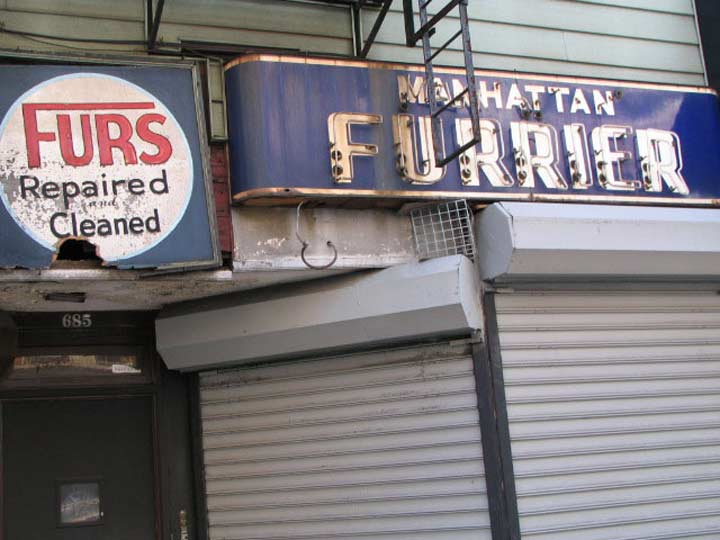
Brooks of Sheffield in Lost City profiled Irving Feller of Manhattan Furrier — which has been in the same family since 1913:
Feller’s an odd duck. He is an abstract painter in this spare time and his works fill the walls of the small place. He is also obsessed with Native American culture. He visits the Kutenai, Shoshone-Bannock, Crow, Nez Perce, Apache, Navajo, Zuni and Hopi out west every year. In his store window are Native American jewelry he has bought from them; everything is for sale.
Manhattan Furrier also offers fur storage. I’ve got to wonder how many people in ramshackle Greenpoint take him up on that offer…
The NY Times profiled Feller when he closed his shop in March 2011.
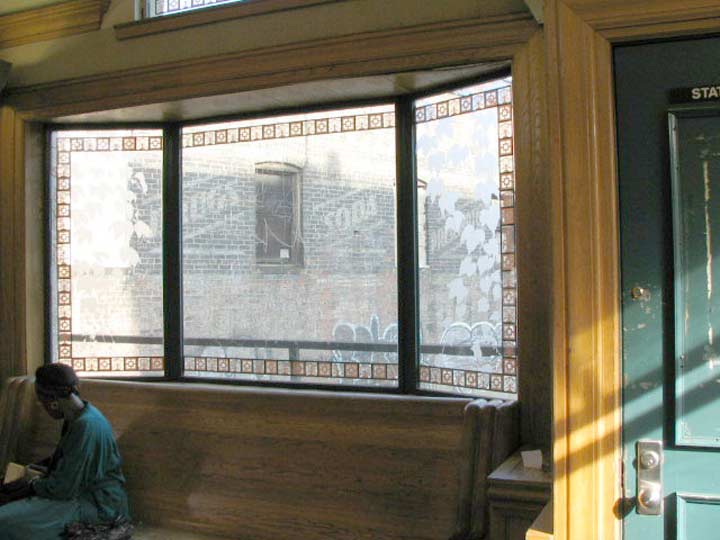
Ancient signage for Greenfield Chemists, which is still in business, can be seen through the window overhanging the subway tracks in the Cortelyou Road station serving the Q train in Beverly Square, Brooklyn.
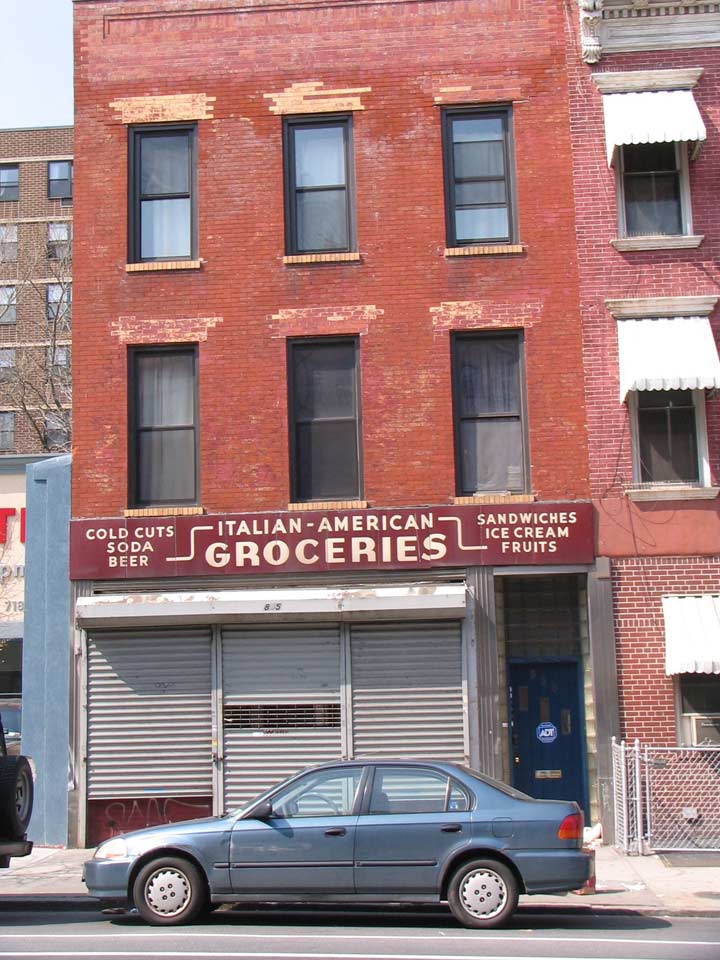
This sign for a long-gone grocery is still there on the north side of Grand Street midblock between Bushwick Avenue and Olive Street in East Williamsburg. A nondescript 6-story apartment building has since gone up on the left.
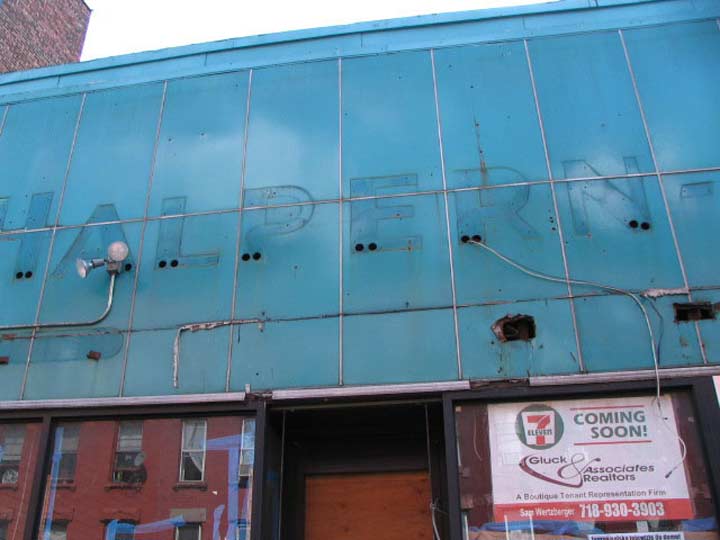
Ghosks is the bunk, as Popeye says, but here is a sign ghost on Manhattan Avenue south of Greenpoint Avenue for Halpern-Perlow, a former men’s store slated for 7-Elevenhood. Halpern-Perlow was in business for over 75 years; Joseph Perlow was president of the (now-inactive) Associated Merchants of Greenpoint in the 1980s.
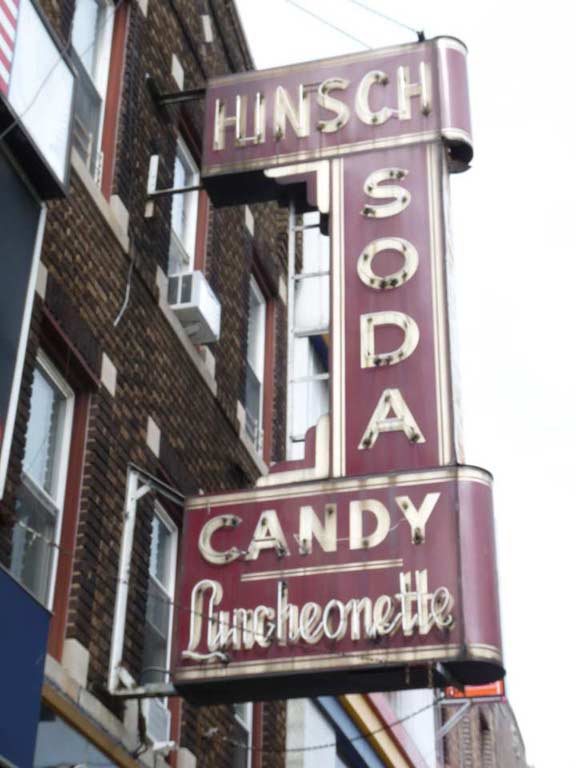
Hinsch’s was originally Riechert’s Tea Room when it opened in 1931 at 8518 5th Avenue, in a brick walkup apartment building with businesses on the ground floor that was constructed in 1921. Reichert’s, despite the name, was an ice cream and candy parlor and did not serve lunch. It was in the 1930s that the first electric neon signs were placed above the business, which was purchased by Bay Ridger Herman Hinsch in 1948; it was he who changed the classic neon signs to reflect the new name, and these signs would remain in place for over six decades.
The classic Hinsch sign was covered up in 2015 when It became a Stewart’s franchisee. I have the whole story on this SpliceToday page.
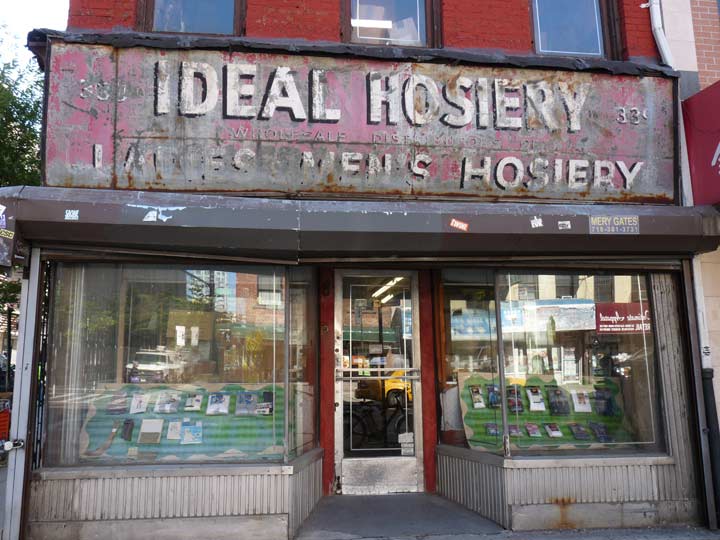
This underwear wholesaler/retailer at 339 Grand Street and Ludlow not only has its 1940s painted sidewalk sign still intact, albeit peeling just a bit by now, but the building in which it is situated was first built in 1832 as a private residence.
Over the years 339 Grand has functioned as the home of the Hebrew Benevolent Orphan Asylum Society of NYC, a kitchenware and stove store, the J. Freund mattress store, and since the 1930s, socks, stockings and underwear. It was once part of a concentration of such outlets in the LES, especially on Orchard Street, that have disappeared one by one.
Ideal has lost its sign on the Ludlow Street side of the building but its weathered, battered Grand Street sign seems ready to go the distance, however long the distance may be.
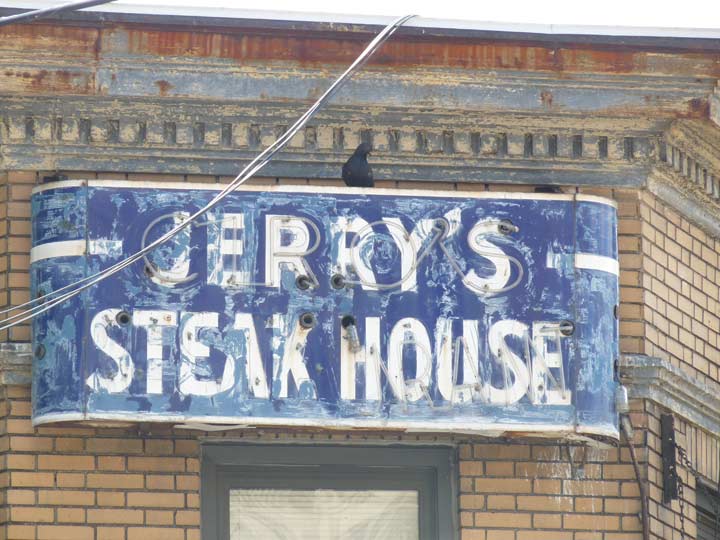
There hasn’t been a Jerry’s Steak House here, on Van Cortlandt Avenue West and Villa Avenue in Norwood, Bronx for probably few decades, but the neon sign is preserved very nicely. However: note that the neon tubes don’t seem to match the lettering underneath. Can anyone make out what it says?
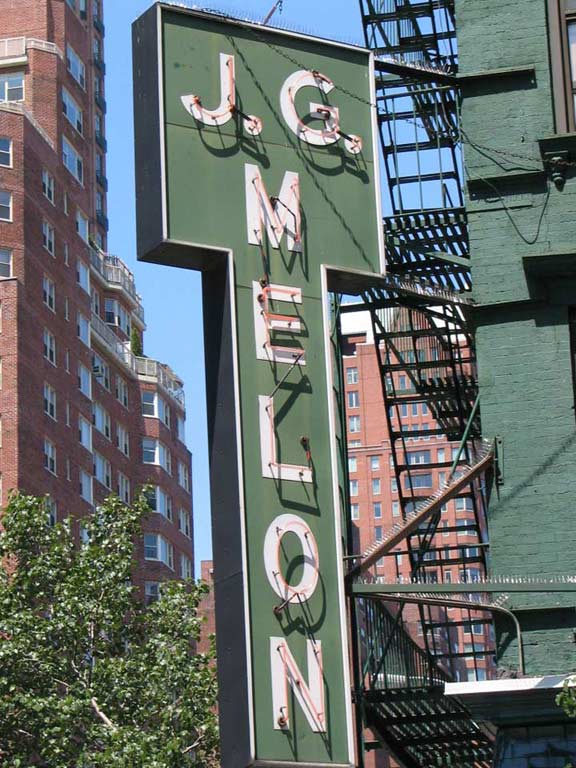
Like so many long-established NYC distributor of potables J.G. Melon (3rd Avenue at East 74th Street) started out as a speakeasy during Prohibition; it has had its present name since 1972. Over the years it has hosted many famed customers including Grace Kelly, Billy Martin, Brooke Shields, Gerry Ford, and a flock of Kennedys. The interior was filmed for a scene in Kramer vs. Kramer. And also like many NYC bars, it claims the city’s best burger, but according to Jef Klein’s Best Bars of New York, J.G. Melon’s burger is endorsed by celebrity chef Bobby Flay. That settles that! The neon still lights up red at night.
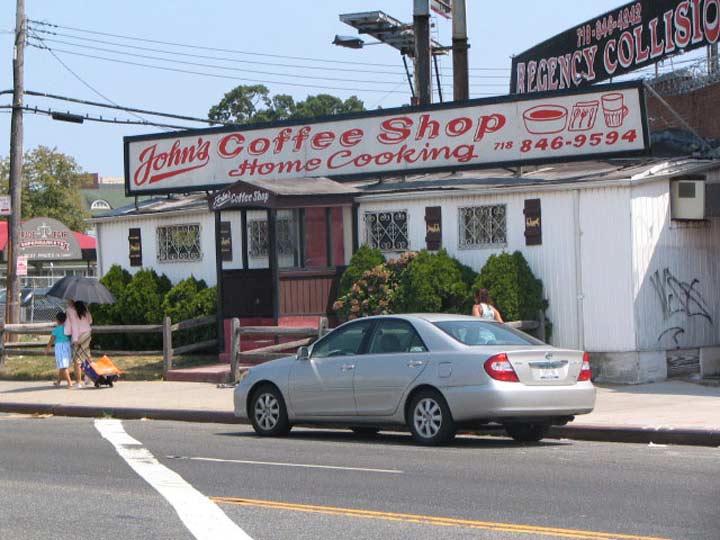
I had always been curious about what used to be John’s Coffee Shop at Hillside and Metropolitan Avenues in Richmond Hill, but I never did get in. A Forgotten Fan recounts…
When I lived in Queens this was a regular stop for my father-in-law. He went in every day and knew both Tas (spelling?) the man who owned this shop and Marsha. It was named for Tas’s father. Last I knew Marsha was running the place. Very wonderful memories! ![]() It’s an old diner car that’s been slightly converted. If you go in expect to pay cash and expect it be crowded for breakfast and lunch rush. Their food is decent, but as the FIL says you go there for the character of the place and the people. I can’t recommend it enough simply because I went there so often when I lived in Richmond Hill.
It’s an old diner car that’s been slightly converted. If you go in expect to pay cash and expect it be crowded for breakfast and lunch rush. Their food is decent, but as the FIL says you go there for the character of the place and the people. I can’t recommend it enough simply because I went there so often when I lived in Richmond Hill.
In 2013, it had had a grand reopening as Ariel’s Coffee Shop, when it was painted yellow with white shutters. The latest that I know aboutis that the place has become a Colombian bakery/restaurant, Acá te Espero.

When I visited Morristown, NJ in 2006 for the first and only time I found this sign. Hopefully it’s still there. Let me know in Comments.
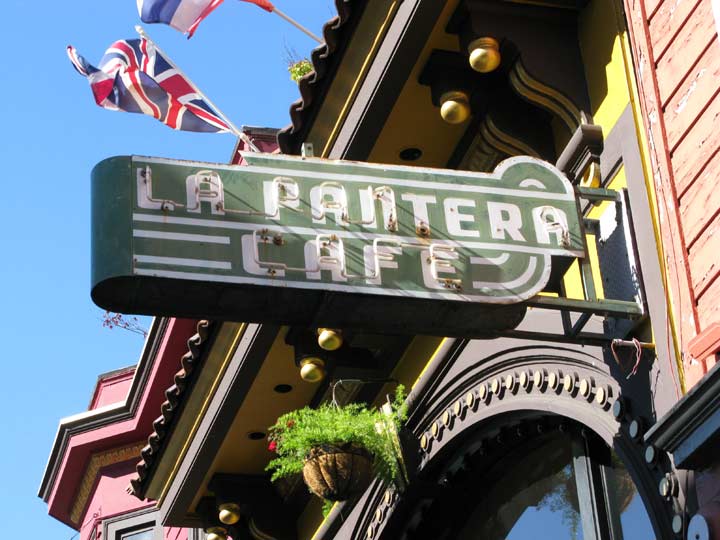
Surprisingly, I found a lot of classic signage in 2008 when I visited San Francisco.
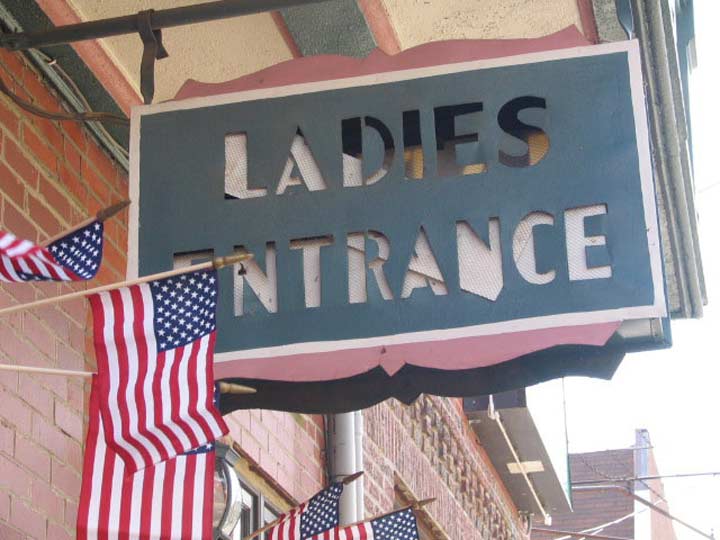
Ditto Philadelphia, the same year. This sign still exists at the North 24th Street Bar & restaurant at Brown Street — I found it while skulking around the neighborhood near the Eastern State Penitentiary. Apparently women once had to use a separate entrance in taverns.
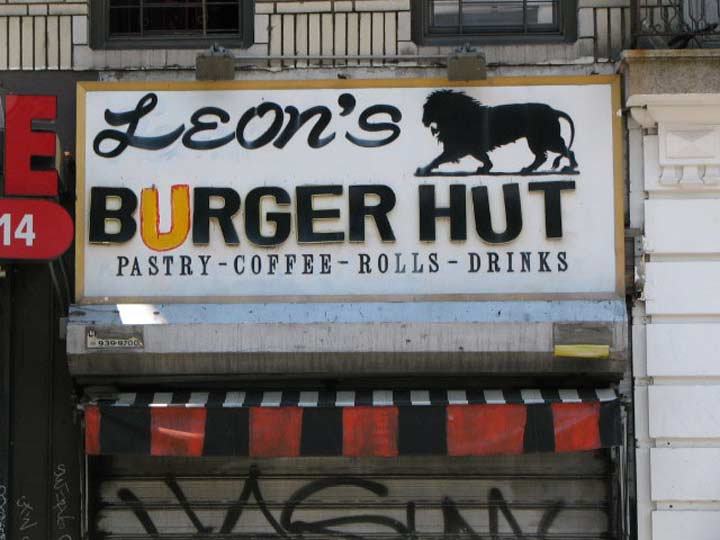
Leon’s Burger Hut, Bedford Avenue just south of Grand Street in Williamsburg, and its engaging sign have since been replaced by a boutique called Babel Fair.
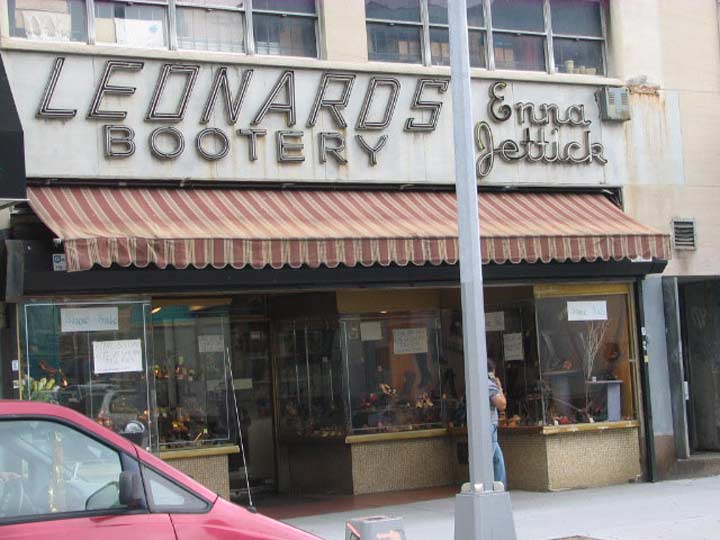
Leonard’s Bootery, on 164th Street between 89th and Jamaica Avenues, kept what must have been its original neon sign from 1939 until it closed in the early 2010s. My mother was a patron of the Enna Jettick brand (“energetic,” get it?)

The Lilian’s Dress Shop sign was briefly uncovered on Hyatt Street in St. George, Staten Island near Borough Hall a few years ago. Superficially it looks like the Lewis Drug Store sign above.
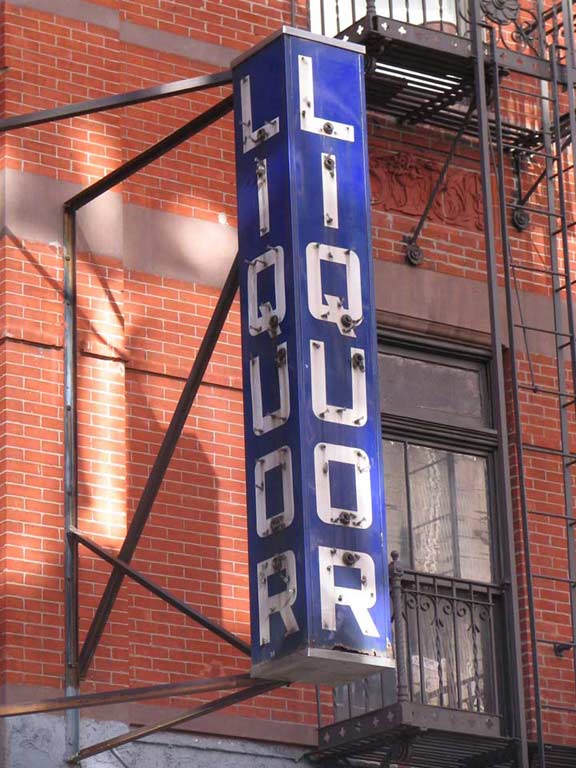
There’s a long-gone liquor store at 6th Avenue and West 24th Street in Chelsea, near where Billy’s Topless used to be; this neon sign is the sole remnant.
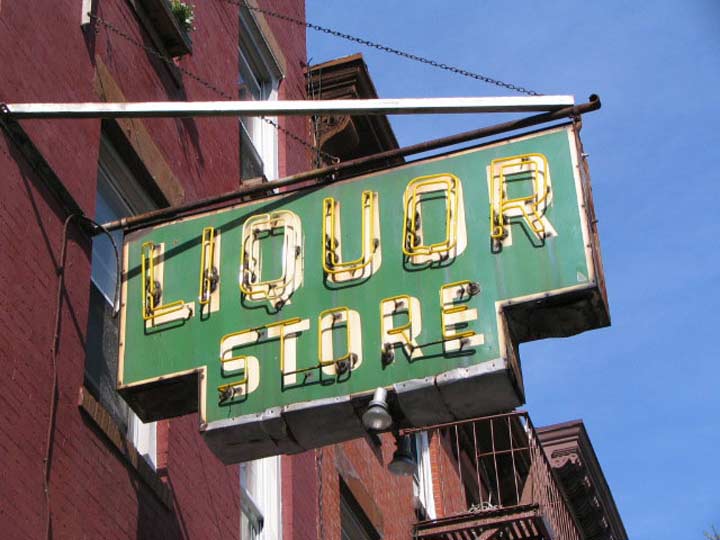
There are more preserved ancient liquor store signs around NYC than any other type; I think drugstores are in second place. This one was on DeKalb Avenue between Adelphi Street and Clermont Avenue.
M&M Pharmacy on, what else, Avenue M and East 19th Street in Midwood carries neon that must go back to the 1940s at least, and still has vintage interior signs, as well. As the awning signage indicates there is also a Russian clientele, spilling north from Brighton Beach along the Brighton subway line.
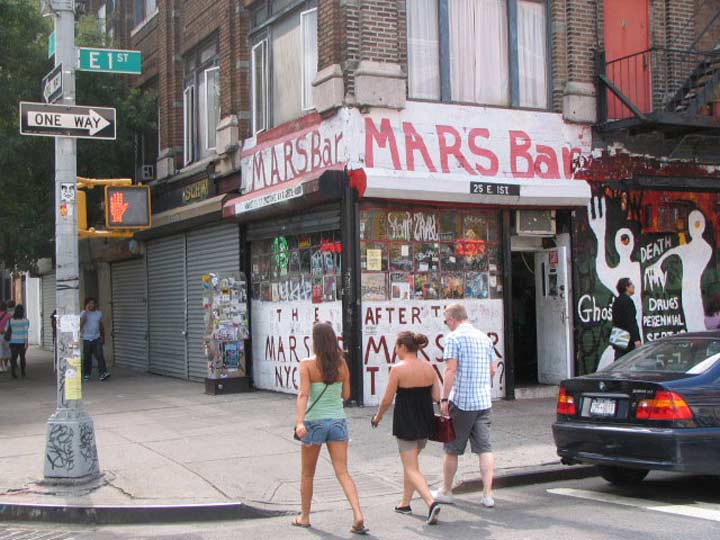
Mars Bar on the SW corner of 2nd Avenue and East 1st Street, which has been called the quintessential New York dive bar by more than one observer. The handwritten sign obscured by the pedestrian reads “After the Mars Bar, then what?” More blandification, I’d say.
Writing in the original (2003) edition of New York’s Best Dive Bars, Wendy Mitchell writes:
Despite the friendly crowd, the Mars Bar more than lives up to its reputation as New York’s King (and Queen and Prince) of dives. If you’re up for adventure, you might find it here, wrapped in many layers of filth. The place is dank, dark and dirty, and the night I was there I saw the largest cockroach I have ever seen in New York City, In addition, the bathroom will put fear in the hearts of mere mortals. It also worried me a bit that the obviously intoxicated bartender (obvious because she was drinking shots) was mixing drinks with orange juice sitting out behind the bar like you’d see at some frat party…
The crowning touch, however, are the cases of beer stacked up in the back like the Great Wall of China, plus dozens upon dozens of empties strewn about the rest of the bar. If all of this isn’t enough to leave your head spinning with wonder at what the seedy years of pre-Giuliani NYC were like, you’re assured of at least a bit of a time warp thanks to an old alarm clock that always reads “Wed Jan 23.”
Mars Bar was covered, inside and out, with amateur and “outsider” art.
As the “gentrification” (i.e., the takeover of market forces) of the East Village continues the corner is now occupied by a glassy high-rise apartment house and a TD Bank on the ground floor.
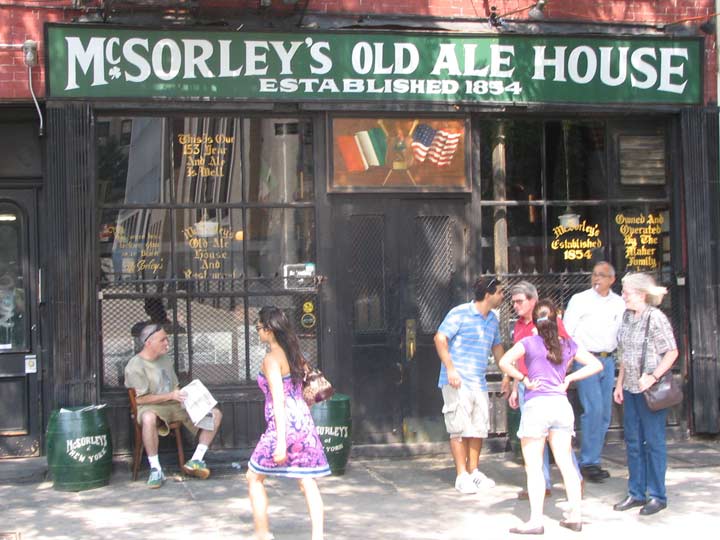
One of my favorite FNY photos — I’ve used it several times — of the bustle outside McSorley’s Old Ale House on East 7th Street east of Cooper Square. Depending on the source, it’s been in business since 1854 or 1862 and has served every stripe from Abe Lincoln to Elvis Presley. Joseph Mitchell’s articles on McSorley’s and other NYC locales should be required reading.
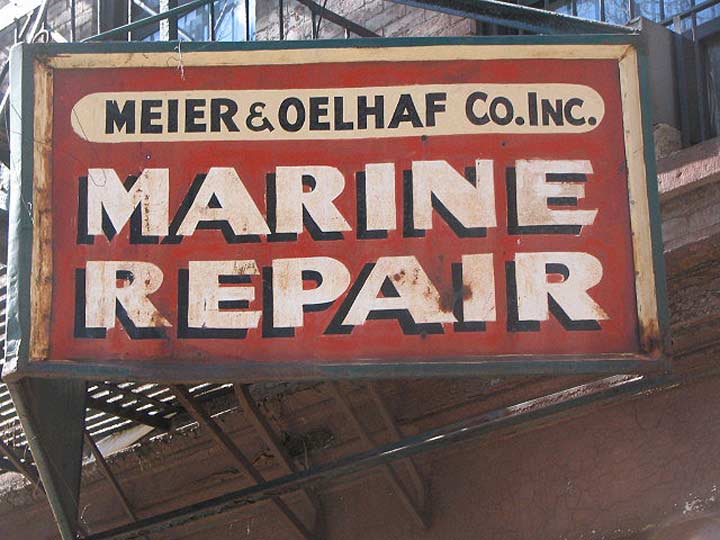
This handsome painted red, black and white sign for a marine repairs firm has hung in there on Christopher Street near Washington in Greenwich Village almost 3 decades after the demise of its parent. It faces 2 sides with an identical sign on each side. Love those drop shadows.
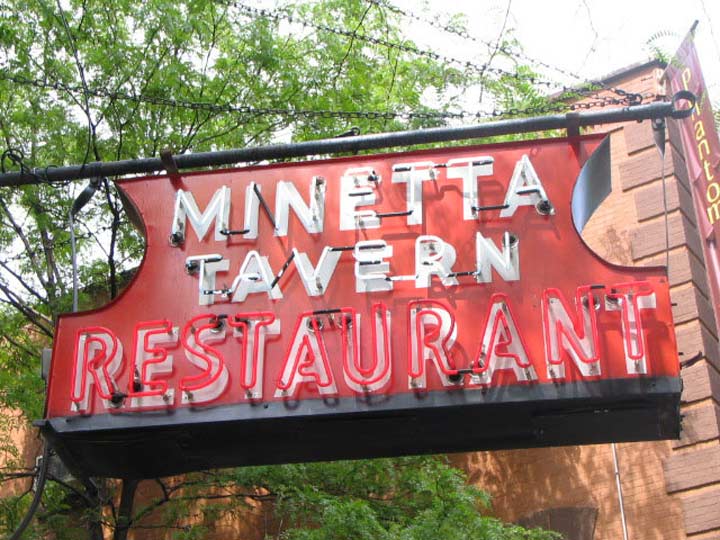
The Minetta Tavern has held down the SW corner of Minetta Lane and MacDougal Street in the Village since 1937, but it had operated as the Black Rabbit speakeasy before that in the Prohibition era. From its early days, the Minetta was a writer’s bar and counted E.E. Cummings, Ezra Pound and Ernest Hemingway among its customers, which also included the New Yorker’s Joseph Mitchell and his discovery, wild-eyed homeless bohemian Joe Gould, who imitated seagulls and bamboozled Mitchell into believing he was producing a multi-volume, the Oral History of Our Time; in the end, it amounted to only a few notebooks of Gould’s scribbled imaginings.
In 2008, restaurateur Keith McNally reopened the Tavern not as a hardscrabble neighborhood watering hole but as an upscale, expensive French restaurant. One thing hasn’t changed, though: its hanging neon sign, which hopefully will be there a few more decades.
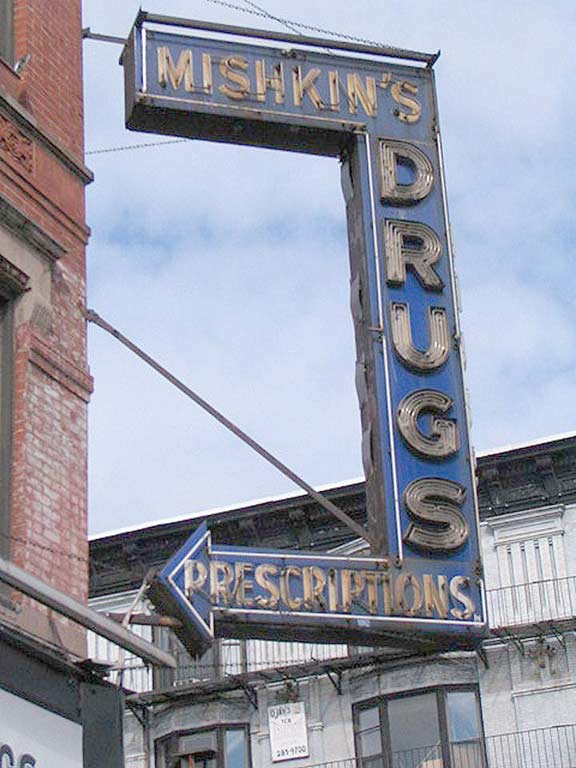
Mishkin’s Pharmacy, southwest corner of W. 145th Street and Amsterdam Avenue, has been an old-school staple for many years. It has recently streamlined its interior, but kept the tower neon sign and hand-lettered signs on the corner doorway pillar.
According to the store’s website, Mishkin’s was started in 1890 by a Russian Jewish immigrant. Later, it appears that Mishkin’s became a New York chain, with a location at 116 W 14th Street by 1964 and another on Columbus. A third Mishkin’s still exists in Brooklyn at Broadway & Kosciusko Street. The Mishkin’s at 145th was purchased by its current owners, Mr. & Mrs. Yoo, around 30 years ago. Scouting New York, 2013
Mishkin’s modernized its sidewalk signage some years ago, but the vertical neon sign is still in place. The Bedford-Stuyvesant Mishkin’s, and its own set of classic signs, remains in place.

Monument Lane restaurant, at 103 Greenwich Avenue in Greenwich Village, memorialized Greenwich Avenue’s original name.
Under Dutch rule in the 1600s the road was called Strand Road but by the colonial era the British had made it a military pathway as it ran through the estate of Admiral Peter Warren, the commander of British naval forces during the Revolution. He had acquired several hundred acres of property in the Village in the 1740s.
After 1762, the road was known as Monument Lane or Road to the Obelisk. In 1762, at the spot where Greenwich Avenue meets 8th Avenue today, the British erected a monument to British Major General James Wolfe (1727-1759) who had died in the Battle of Quebec in the Seven Years’ War, but by 1773, before American independence was declared, the monument had disappeared from local maps.
Much more on Greenwich Avenue and Monument Lane
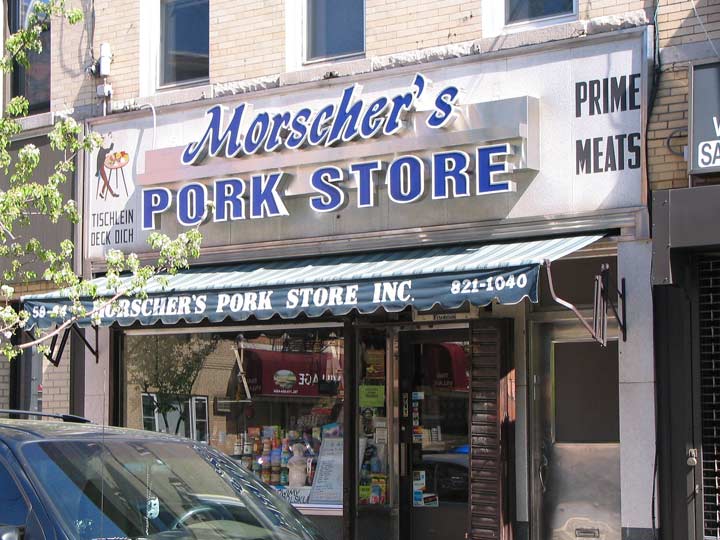
The German inscription on the Morscher’s Pork Store sign, Woodward and Catalpa Avenues in Ridgewood, Tischlein, deck dich, means, roughly: “little table, set yourself” and is taken from the Grimm brothers’ classic story “The Wishing-Table, the Gold-Ass, and the Cudgel in the Sack” (the context is a magic table that sets itself). Morscher’s is one of a series of butcher shops that have been in this location since the early 1900s, Morscher’s itself since 1957. The shop features sremska (Hungarian sausage), debricina (Slovenian sausage), kielbasa, wursts of every thickness and mildness or strength, general meat cuts, cheeses, and imported European canned goods.
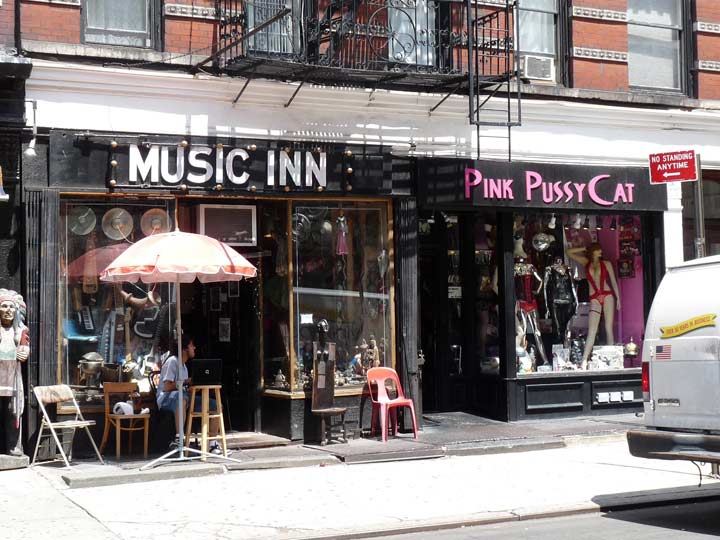
Music Inn, on West 4th west of 6th, has been in business since 1958 and has sold guitars to the likes of John Lennon, Bob Dylan and John Sebastian, while the Pink Pussycat sextoy shop is almost as venerable, established 1972.
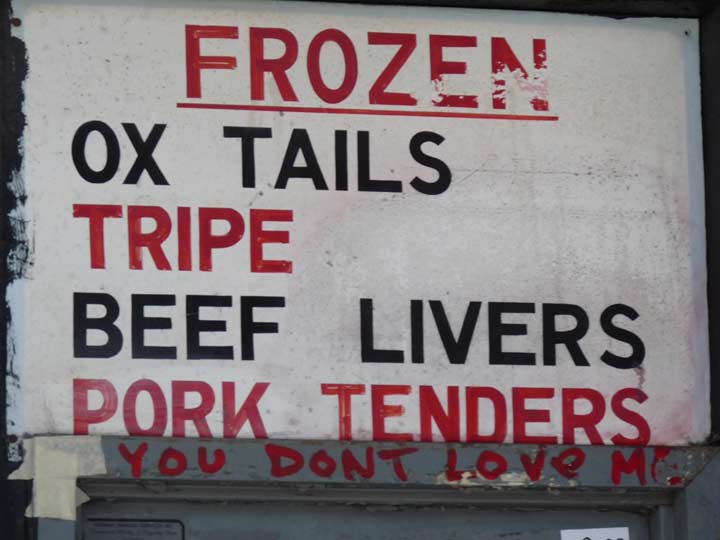
I first encountered the Meatpacking District in 1983 when I walked through its streets, empty by day but suffused with the aroma of raw meat. When I worked at Macy’s from 2000-2004 I would take the subway down here on my lunch hour, past hooks swinging with cow carcasses and discarded bones in plastic hampers, fascinated by the city’s hidden enclaves. I ate lunch with friends at Florent, a restaurant pioneer serving patrons of Hogs and Heifers, hookers, office workers and meatpackers in the area.
“Market forces” took over and most of the old Meatpacking is now filled with upscale apartment buildings, restaurants and retail, anchored by the Apple Store at 9th Avenue and West 14th. Some of the old meat wholesalers still hold fast on West 13th Street.
This was one of the last remaining signs on one of Washington Street’s meat businesses.
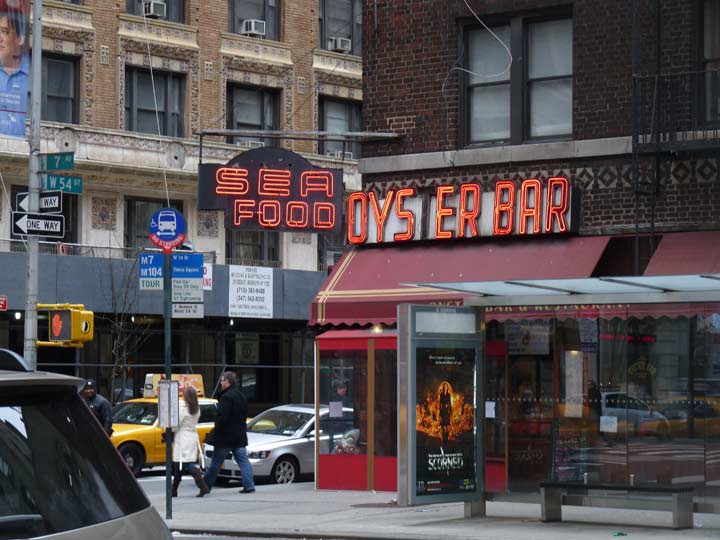
The Oyster Bar (nothing to do with Grand Central Terminal’s) seafood joint held down the corner of 7th Avenue and West 54th for many years.

It took about 60 years for vinyl LPs to take over from hard lacquer 78s, and then another 30-35 or so for CDs to take over from LPs, with a strong challenge from 8-tracks and cassettes in the 1970s. MP3s, which don’t require a cover or artwork at all, became widespread beginning around 2001 with the advent of Apple’s ITunes and in only about 12 years, seem primed to wipe out CDs.
But until then the Shiree, Grand Street near Bushwick Avenue, with its handmade stenciled awning sign and display window full of vinyl and discs will survive.
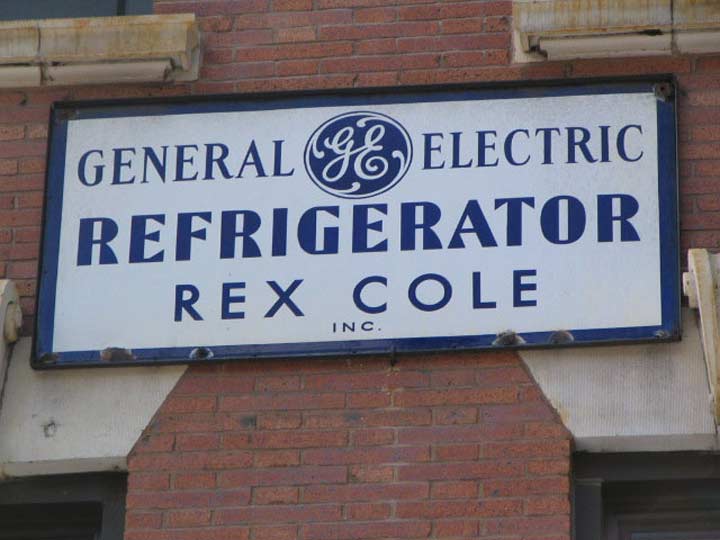
Who was Rex Cole and why is his refrigerator on so many NYC housing projects? Cole (1887-1967) was originally a lamp manufacturer, then became associated with General Electric in the 1920s and designed white enamel Monitor Top refrigerators. Famed architect Raymond Hood designed a series of buildings in Bay Ridge, Brooklyn, the Grand Concourse, and Northern Blvd. in Flushing for Cole’s showrooms that either looked like refrigerators or featured them in the design! Most are still standing but have been altered beyond recognition. Enamel signs proclaiming Cole’s GE refrigerators can still be found on a handful of buildings around town.
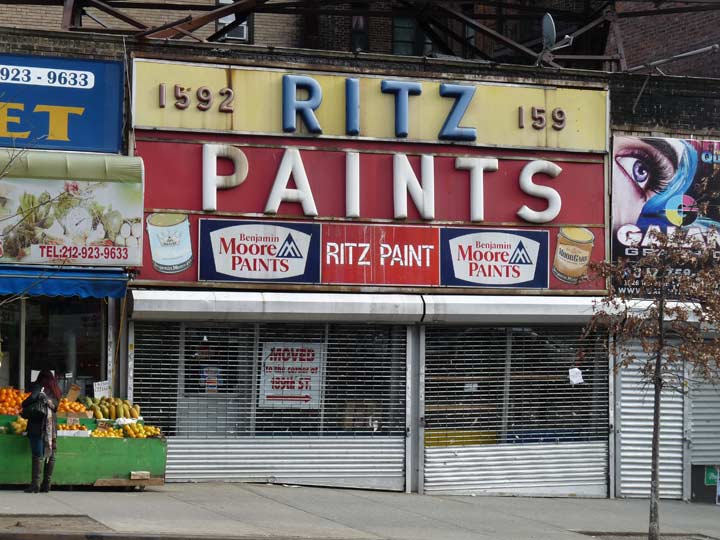
Paint store signs often have rainbow-colored signs and this one, St. Nicholas Avenue between West 189th and 190th Street in Washington Heights is no exception.
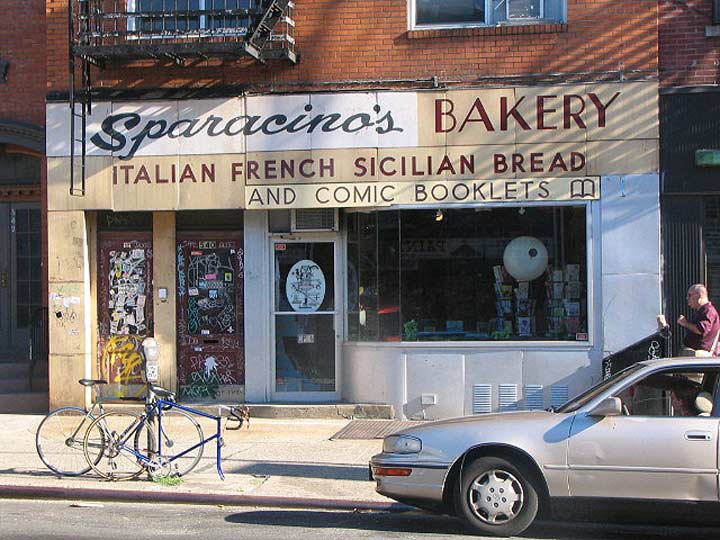
There has not been a Sparacino’s Bakery on Met Ave. just east of Union Avenue for a couple of decades, but the owner of Desert Island, a comic book store/esoteric bookstore, has retained the vinyl sign since he enjoys the design. (He formerly added a sign called “and comic booklets” in the yellow panel at the bottom of the sign and even sent so far as to duplicate the font as best as possible, but that is missing these days).
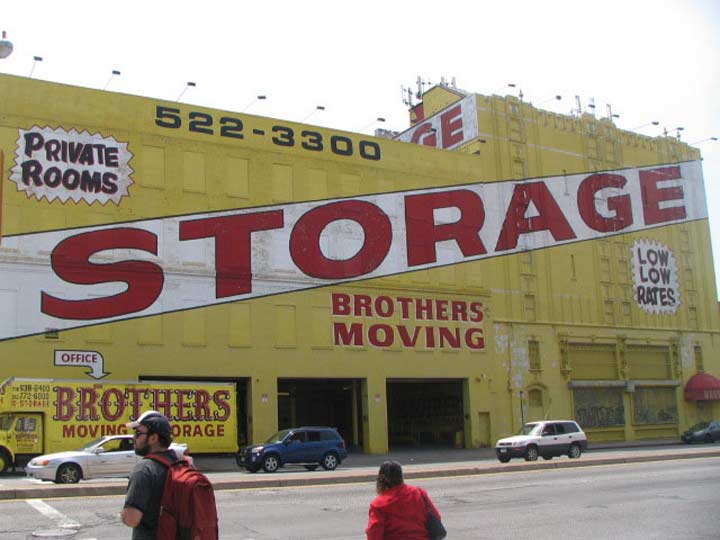
This is the largest painted ad I ever saw, Washington and Atlantic Avenues in Prospect Heights, across the street from my old high school, Cathedral Prep. The plot is still home to a storage facility but it’s now painted red and blue.
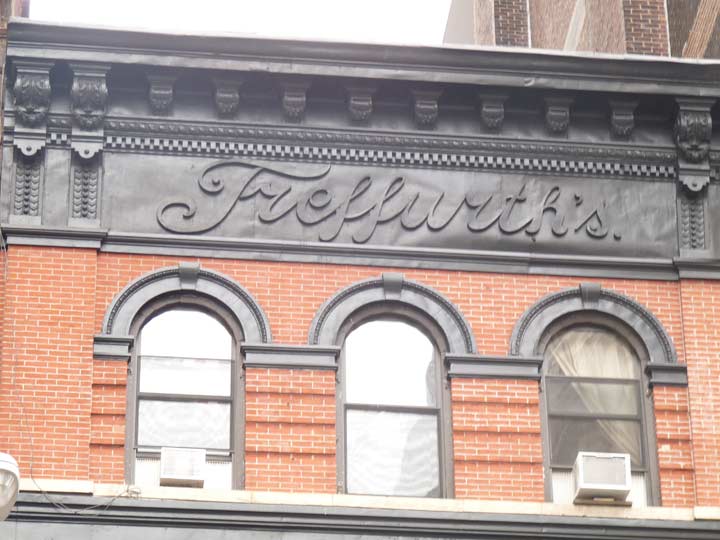
At the top of a grand old building at Broadway and Washington Place in Greenwich Village is a sign that says “Treffurth’s.”
Treffurth’s was a noted restaurant on Broadway at the turn of the century. The building, according to the book “A Walk On Broadway: A Journey Over Time” by David Dunlap, dates to 1882.
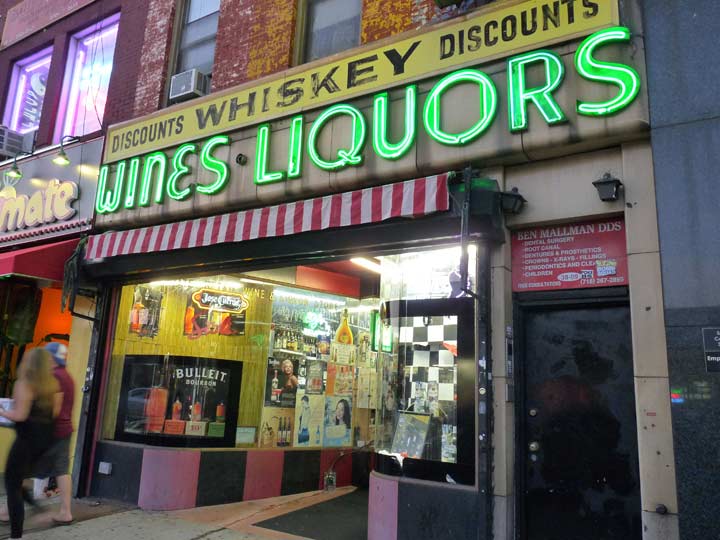
This liquor store on Broadway and Steinway Street in Astoria has been here since 1948. Until recently its green neon sign was working, too. However in 2016, the neon burned out and the outline of the letters was kept, but filled with LED lights that change colors.
Please help contribute to a new Forgotten NY website
Check out the ForgottenBook, take a look at the gift shop, and as always, “comment…as you see fit.”
8/19/18

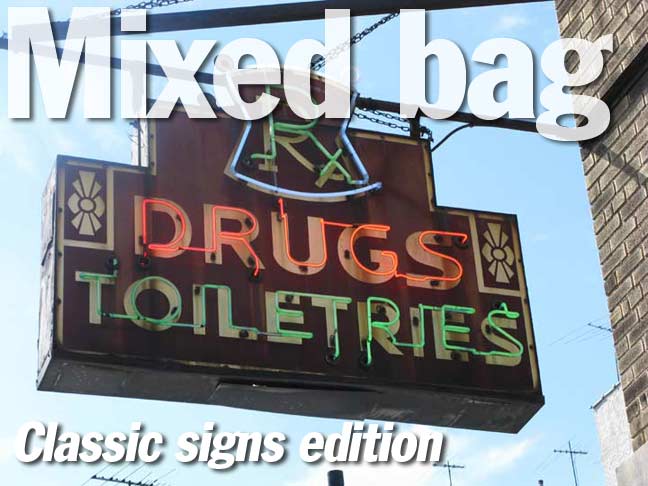
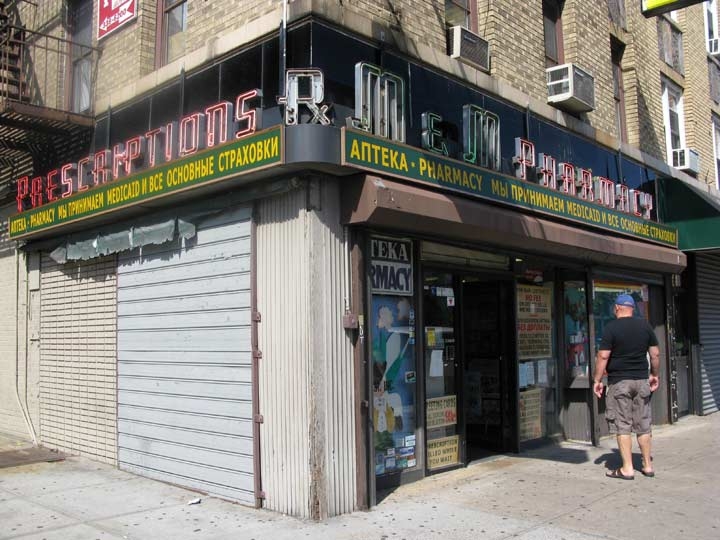
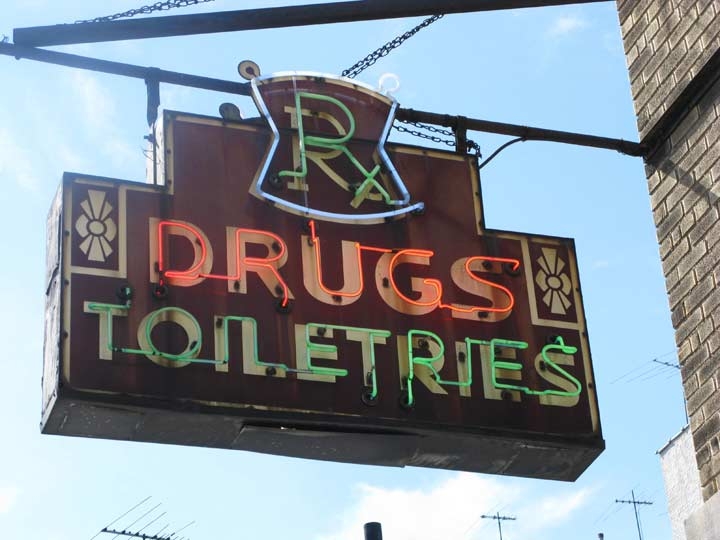
10 comments
The “Chow Mein” sign was over the Jade Mountain restaurant, 197 Second Avenue near 12th Street in Manhattan. The restaurant closed in 2007 and the sign was taken down in 2011.
http://evgrieve.com/2011/07/workers-remove-iconic-chow-mein-sign-on.html
The mystery chow mein sign is from the old Jade Mountain restaurant on 2nd Avenue in Manhattan: https://forgotten-ny.com/2012/01/five-squares-part-1-madison-to-union/
The “Jerry’s Steakhouse” sign became “Ciro’s Pizza”, which residents identified the previous time: https://forgotten-ny.com/2011/10/grand-concourse-part-2/
Looks like “Jerry’s” was originally “Ciro’s” Steak House.
Check out Goldbergers Pharmacy at 65th St and 1st Ave. Retro neon.
The Chow Mein sign was at the old Jade Mountain restaurant at 197 Second Avenue (at 12th Street) in the East Village. It was removed in 2011.
The neon over the Jerry’s Steak House sign looks like “Cipo’s Restaurant”.
That Chow Mein sign was in front of an old Chinese restaurant.
Anyone who thinks the Mars Bar is a dive has never been to the old Half Moon on lower Bowery back in the 1960s.
That place would make the Mars Bar look like a Howard Johnson’s
The Oyster Bar neon sign now hangs on the Grey Lady restaurant at Delancey and Allen, as I’m sure you’re already well aware. I believe the owner bought the Seafood signage also but has it in storage.
https://youtu.be/X3aGiVlNugA for lost storefronts